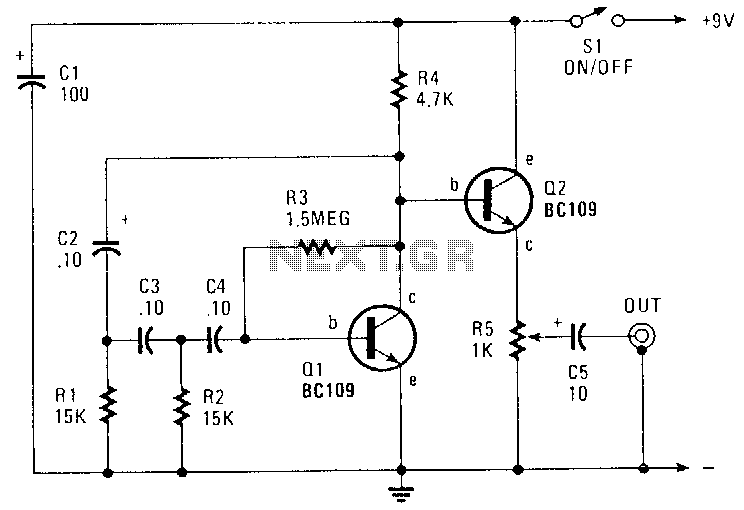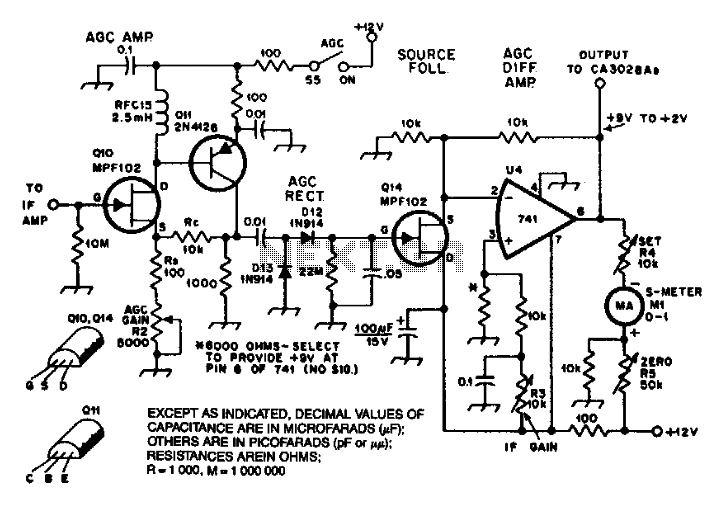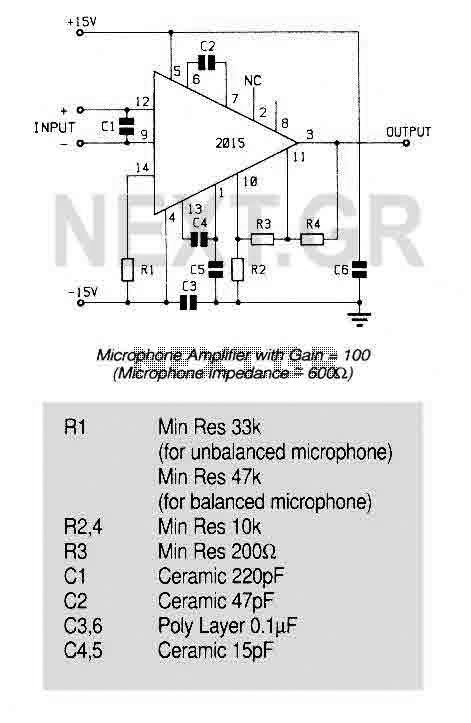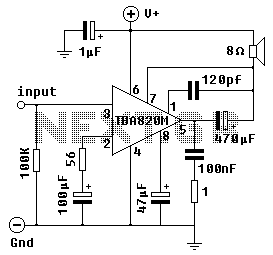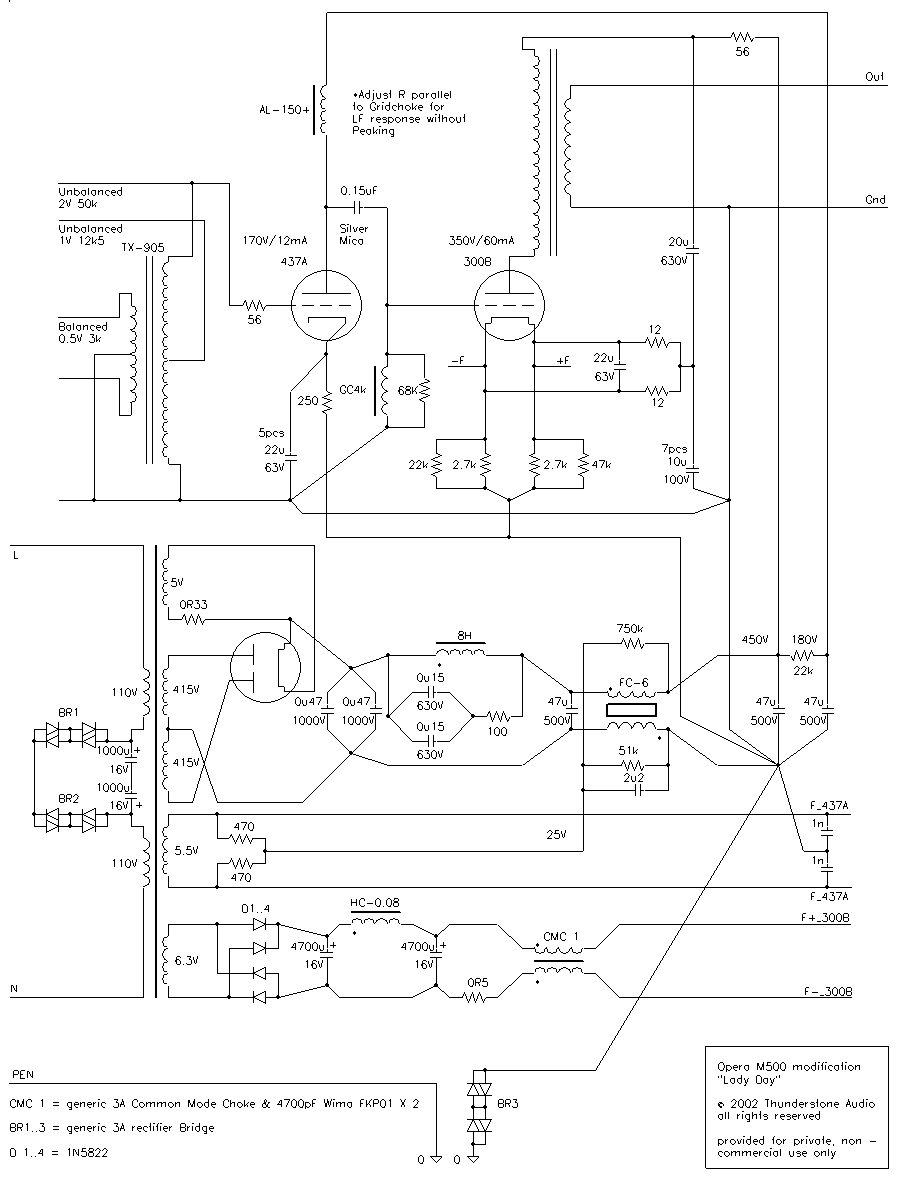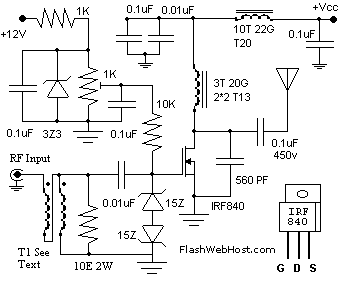
25W HiFi Audio Amplifier with MOSFET
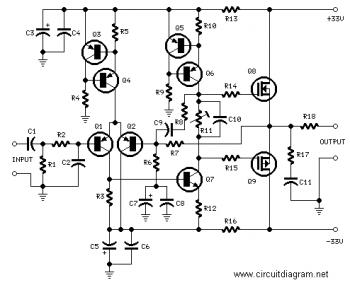
This circuit can be directly connected to CD players, tuners, and tape recorders. It requires the addition of a 10K logarithmic potentiometer (dual gang for stereo) and a switch to accommodate various sources. Proper grounding is crucial to eliminate hum and ground loops. The ground connections for resistors R1, R4, R9, and capacitors C3 to C8 should be tied together. Capacitor C11 should be connected to the output ground. Input and output grounds must be connected separately to the power supply ground. This circuit diagram is simple and cost-effective. The amplifier components include: P1 = 22K Log Potentiometer (Dual-gang for stereo), R1 = 1K 1/4W Resistor, R2 = 4K7 1/4W Resistor, R3 = 100R 1/4W Resistor, R4 = 4K7 1/4W Resistor, R5 = 82K 1/4W Resistor, R6 = 10R 1/2W Resistor, R7 = R22 4W Resistor (wirewound). This is a simple and inexpensive mixer circuit powered by a 9V power supply and features high/low sensitivity switchable inputs for each channel. The component list includes P1, P2, P3 = 5K Linear Potentiometers, R1, R11, R15 = 180K 1/4W Resistors, R2, R12, R16 = 2M2 1/4W Resistors, R3, R13, R17 = 750R 1/4W Resistors, R4, R14, R18 = 1K 1/4W Resistors, R5 = 15K 1/4W Resistor, R6 = 220R 1/4W Resistor, R7 = 1K5 1/4W Resistor, R8 = 820R 1/4W Resistor, R9 = 150R 1/4W Resistor. The circuit diagram for a 25-watt high-fidelity audio amplifier is based on the single power amplifier IC LM1875. The component list includes R1 = 1K, R2 = 1M, R3 = 22K, R4 = 10K, R5 = 180K, R6 = 1R, IC1 = LM1875, C1 = 1uF 50V, C2, C6 = 100nF, C3 = 22uF 63V. Built using an operational amplifier NE5532 and a pair of power transistors TIP41A and TIP42A, this audio amplifier circuit can deliver up to 10W of audio power output into an 8-ohm speaker. The amplifier parts list includes P1 = 22K Log Potentiometer, P2 = 100K Log Potentiometer, R1 = 820R, R2, R4, R8 = 4K7, R3 = 500R Trimpot. Additionally, there is a circuit for dancing LEDs consisting of 10 units. This circuit functions as an audio level meter, with the LEDs sequencing in response to the sound levels detected by the microphone. The components for this circuit include R1 = 10K 1/4W Resistor, R2, R3 = 47K 1/4W Resistors, R4 = 1K 1/4W Resistor, R5, R6, R7 = 100K 1/4W Resistors, R8 = 820R 1/4W Resistor, C1, C3 = 100nF 63V Ceramic.
This circuit design is versatile and can be effectively utilized in various audio applications. The integration of a dual-gang potentiometer allows for precise volume control in stereo setups, enhancing user experience. The grounding strategy is critical; by connecting the grounds of multiple components at a single point, the design minimizes potential noise issues that can arise from ground loops. This is particularly important in audio circuits where hum can significantly degrade sound quality.
The amplifier section, utilizing the LM1875, is capable of delivering substantial power while maintaining fidelity, making it suitable for high-quality audio reproduction. The choice of resistors and capacitors in the design ensures that the amplifier operates within optimal parameters, providing clear and powerful sound output.
In addition, the inclusion of switchable sensitivity inputs allows the mixer circuit to accommodate various audio sources, enhancing its functionality in different scenarios. The use of linear potentiometers for input adjustment provides smooth control over the audio levels.
The dancing LED circuit serves as an engaging visual representation of audio levels, making it a popular addition to audio equipment. The design of this circuit ensures that the LEDs respond dynamically to sound, providing an interactive element that can enhance the overall aesthetic of an audio setup.
Overall, the combination of these circuits creates a comprehensive audio system that is both functional and visually appealing, suitable for a range of applications from home audio systems to live performances.Can be directly connected to CD players, tuners and tape recorders. Simply add a 10K Log potentiometer (dual gang for stereo) and a switch to cope with the various sources you need. A correct grounding is very important to eliminate hum and ground loops. Connect in the same point the ground sides of R1, R4, R9, C3 to C8. Connect C11 at output grou nd. Then connect separately the input and output grounds at power supply ground. This circuit diagram is quite simple and cheap. Amplifier parts: P1 = 22K Log. Potentiometer (Dual-gang for stereo) R1 = 1K 1/4W Resistor R2 = 4K7 1/4W Resistor R3 = 100R 1/4W Resistor R4 = 4K7 1/4W Resistor R5 = 82K 1/4W Resistor R6 = 10R 1/2W Resistor R7 = R22 4W Resistor (wirewound) R8 =. Simple and cheap mixer circuit. This circuit supplied using 9V power supply. There is high/low-sensitivity switchable inputs for each input channel. Component part list: P1, P2, P3_5K Linear Potentiometers R1, R11, R15_180K 1/4W Resistors R2, R12, R16_2M2 1/4W Resistors R3, R13, R17_750R 1/4W Resistors (See Notes) R4, R14, R18_1K 1/4W Resistors R5_15K 1/4W Resistor R6_220R 1/4W Resistor R7_1K5 1/4W Resistor R8_820R 1/4W Resistor R9_150R 1/4W.
Here the circuit diagram of 25 watt high fidelity audio amplifier that build based on single Power Amplifier IC LM1875. Component part list R1 _ 1K R2 _ 1M R3 _ 22K R4 _ 10K R5 _ 180K R6 _ 1R IC1 _ LM1875 C1 _ 1uF 50V C2, 6 _ 100nF C3 _ 22uF 63V.
Build based operational amplifier NE5532 and a couple of power transistor TIP41A / TIP42A, this audio amplifier circuit has capability to deliver up to 10W audio power output into 8 ohm speaker. Amplifier Parts list: P1 22K = Log. Potentiometer P2 = 100K Log. Potentiometer R1 = 820R R2, R4, R8 = 4K7 R3 = 500R Trimpot. This is the circuit of dancing LEDs which consists of 10 units LEDs. The circuit works like a audio level meter. The LEDs will be dance sequence with the sound level that entering the microphone. Components list: R1_10K 1/4W Resistor R2, R3_47K 1/4W Resistors R4_1K 1/4W Resistor R5, R6, R7_100K 1/4W Resistors R8_820R 1/4W Resistor C1, C3_100nF 63V Ceramic.
🔗 External reference
This circuit design is versatile and can be effectively utilized in various audio applications. The integration of a dual-gang potentiometer allows for precise volume control in stereo setups, enhancing user experience. The grounding strategy is critical; by connecting the grounds of multiple components at a single point, the design minimizes potential noise issues that can arise from ground loops. This is particularly important in audio circuits where hum can significantly degrade sound quality.
The amplifier section, utilizing the LM1875, is capable of delivering substantial power while maintaining fidelity, making it suitable for high-quality audio reproduction. The choice of resistors and capacitors in the design ensures that the amplifier operates within optimal parameters, providing clear and powerful sound output.
In addition, the inclusion of switchable sensitivity inputs allows the mixer circuit to accommodate various audio sources, enhancing its functionality in different scenarios. The use of linear potentiometers for input adjustment provides smooth control over the audio levels.
The dancing LED circuit serves as an engaging visual representation of audio levels, making it a popular addition to audio equipment. The design of this circuit ensures that the LEDs respond dynamically to sound, providing an interactive element that can enhance the overall aesthetic of an audio setup.
Overall, the combination of these circuits creates a comprehensive audio system that is both functional and visually appealing, suitable for a range of applications from home audio systems to live performances.Can be directly connected to CD players, tuners and tape recorders. Simply add a 10K Log potentiometer (dual gang for stereo) and a switch to cope with the various sources you need. A correct grounding is very important to eliminate hum and ground loops. Connect in the same point the ground sides of R1, R4, R9, C3 to C8. Connect C11 at output grou nd. Then connect separately the input and output grounds at power supply ground. This circuit diagram is quite simple and cheap. Amplifier parts: P1 = 22K Log. Potentiometer (Dual-gang for stereo) R1 = 1K 1/4W Resistor R2 = 4K7 1/4W Resistor R3 = 100R 1/4W Resistor R4 = 4K7 1/4W Resistor R5 = 82K 1/4W Resistor R6 = 10R 1/2W Resistor R7 = R22 4W Resistor (wirewound) R8 =. Simple and cheap mixer circuit. This circuit supplied using 9V power supply. There is high/low-sensitivity switchable inputs for each input channel. Component part list: P1, P2, P3_5K Linear Potentiometers R1, R11, R15_180K 1/4W Resistors R2, R12, R16_2M2 1/4W Resistors R3, R13, R17_750R 1/4W Resistors (See Notes) R4, R14, R18_1K 1/4W Resistors R5_15K 1/4W Resistor R6_220R 1/4W Resistor R7_1K5 1/4W Resistor R8_820R 1/4W Resistor R9_150R 1/4W.
Here the circuit diagram of 25 watt high fidelity audio amplifier that build based on single Power Amplifier IC LM1875. Component part list R1 _ 1K R2 _ 1M R3 _ 22K R4 _ 10K R5 _ 180K R6 _ 1R IC1 _ LM1875 C1 _ 1uF 50V C2, 6 _ 100nF C3 _ 22uF 63V.
Build based operational amplifier NE5532 and a couple of power transistor TIP41A / TIP42A, this audio amplifier circuit has capability to deliver up to 10W audio power output into 8 ohm speaker. Amplifier Parts list: P1 22K = Log. Potentiometer P2 = 100K Log. Potentiometer R1 = 820R R2, R4, R8 = 4K7 R3 = 500R Trimpot. This is the circuit of dancing LEDs which consists of 10 units LEDs. The circuit works like a audio level meter. The LEDs will be dance sequence with the sound level that entering the microphone. Components list: R1_10K 1/4W Resistor R2, R3_47K 1/4W Resistors R4_1K 1/4W Resistor R5, R6, R7_100K 1/4W Resistors R8_820R 1/4W Resistor C1, C3_100nF 63V Ceramic.
🔗 External reference
